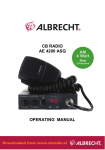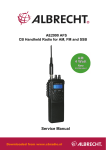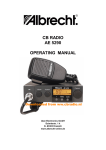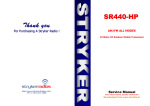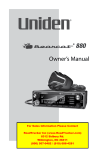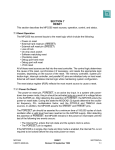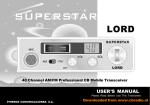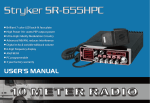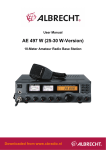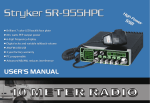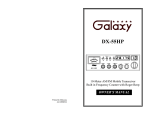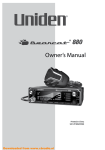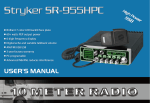Download www.cbradio.nl: Manual Stryker SR
Transcript
SR-447HPC AM/FM/PA 10 Meter HF Amateur Mobile Transceiver USER’S MANUAL READ THIS MANUAL BEFORE OPERATION Downloaded from www.cbradio.nl INTRODUCTION Congratulations on your purchase of a Stryker 10 meter mobile amateur transceiver. Your Stryker is designed to provide years of enjoyment and trouble-free service. There are many features and functions designed into this transceiver. To ensure that your investment is enjoyed to its fullest extent, please take a few moments and thoroughly read this manual. LIMITED WARRANTY Stryker Amateur Radio warrants this product to be free of defects for a period of one (1) year from the original date of purchase. You must activate your warranty by completing the included form or online at www.strykerradios.com/register.aspx This warranty is non-transferable. This limited warranty is subject to repair or replacement of defective components only. This warranty is void if the radio has been tampered with or misused. If your Stryker Radios needs repair any time during the (1) year warranty period please visit our website: www.StrykerRadios.com to obtain an RA number or call 910-221-1086 between the hours of 10 a.m. – 5 p.m. Eastern standard time. If you do need service after your warranty has expired you can still send your radio to us for repair. Our rates are very reasonable and you can rest assured that your radio will be fixed correctly. IMPORTANT: RETAIN YOUR SALES RECEIPT You will need to include a copy of your original sales receipt along with your radio when sending it in for warranty repair. INSTALLATION 1. Contents Unpack and inspect your Stryker SR-447/497 for missing or damaged Components. Quantity Description 1 1 1 1 1 Stryker SR-447/497 Transceiver Microphone DC Power Cord with Inline Fuse Mounting Bracket with Hardware Microphone Hanger with Hardware Set 1 INSTALLATION CONTINUATION Location Plan the location of the transceiver and microphone brackets before starting the installation. Select a location that is convenient for operation and does not interfere with the driver or passengers in the vehicle. In automobiles, the transceiver is usually mounted below the dash panel, with the microphone bracket beside it. Mounting Your mobile radio is supplied with a universal mounting bracket. When mounting the bracket and radio to your car, make sure it is mechanically strong. Also provide a good electrical connection to the chassis of the vehicle. Proceed as follows to mount the transceiver: Mount the Transceiver After you have determined the most convenient location in your vehicle, hold the mobile radio with the mounting bracket in the exact location desired. If nothing will Interfere with mounting it in the desired position, remove the thumbscrews and use the mounting bracket as a template to mark the holes for the mounting screws. Before drilling the holes, make sure nothing behind the surface will be damaged or interfere with the installation. Electrical Connections The Stryker SR447/497 is designed to work on any 13.8 volt DC, negative ground electrical source. The condition of a vehicle’s electrical system can have a profound affect on the performance of the radio. A low battery, worn generator/alternator, or poor voltage regulator will seriously impair the performance of the transceiver. Any of the above conditions could result in a high level of receiver noise generation or a Substantial loss of the transmitter’s RF output. Make sure that all these components on your vehicle’s electrical system are in good condition prior to installing the transceiver. CAUTION! VOLTAGE EXCEEDING 15 Volts DC WILL DAMAGE THE RADIO. MEASURE VOLTAGE AT BATTERY TERMINALS, WITH VEHICLE RUNNING, PRIOR TO INSTALLATION! 1. Before making any electrical connections make sure the volume (VOL) control is in the“OFF” position. 2. Connect the positive (+) red wire of the DC power cord to a positive 13.8-volt source at the vehicle fuse block. If connecting to the fuse block, it is recommended that a switched power source be used so that the power to the Transceiver is disconnected when the vehicle is off. This eliminates the possibility the transceiver draining the vehicle’s battery. 3. Connect the negative (-) black wire to a metal part of the vehicle’s frame, or chassis ground. Make sure that this is a good ground connection. Antenna Connections The Stryker SR447/497 has a jack in the rear for a standard PL-259 antenna plug. If you are looking for the most range for your transmission, use a vertically polarized, quarter-wave length antenna. If antenna height is a problem, you may use a shorter, loaded-type whip antenna although you can expect some loss of transmission range. Your antenna should always be adjusted for the lowest possible SWR (1.5 or less.) To adjust your antenna for best performance you must use a SWR meter, these can be purchased separately for at little as $12.95 from various retailers. Failure to properly adjust your antenna(s) will diminish your operational range and could result in damage to your radio. Damage that results from operating with high SWRs is not covered under your factory warranty! Tuning the Antenna for Optimum SWR Because such a wide variety of base and mobile antennas are available, this section will concern itself only with the usual types of mobile adjustable antennas. Antenna length is directly related to signal frequency. Therefore, it must be tuned to resonate optimally throughout the frequency range of the transceiver. Lower frequencies require a longer antenna than higher frequencies. Due to the various methods of adjusting antennas for proper SWR, we have chosen what we think is the optimum method: A. Antennas with adjustable screws (setscrews). 1. Start with the antenna extended and tighten the setscrew lightly enough so that the antenna can be lightly tapped with your finger for easy adjustment. 2. Set your Stryker radio to your desired operating frequency or the center of the range of frequencies you plan to use. Press the PTT (Press-To-Talk) switch, and tap the antenna (making it shorter). The SWR meter will show a lower reading each time the antenna is tapped. By continuing to shorten the antenna, you will notice the SWR reading will reach a low point and then start rising again. This means that you have passed the optimum point for the middle frequency. 3. Extend the antenna a short distance and again follow the procedure above. 4. When the lowest point has been reached, switch to the lowest frequency you plan to operate on and then to the highest and compare SWR readings. They should be almost equal. B. Antennas that must be cut to proper length. 1. Follow the procedure as in A above, but adjust the length by cutting in 1∕8" increments until a good match is obtained. 2. Be very careful not to cut too much off the antenna at one time. Once it is cut, it can no longer be lengthened. 3 Tuning the Antenna for Optimum SWR CONTINUATION 3. The whip is easily cut by filing a notch all the way around, then breaking the piece off with pliers. NOTE The proper setting is achieved when the SWR is 1.5 or below and when it has the same reading for the low and high frequencies in the range you plan to use. External Speaker The external speaker jack (EXT) on the rear panel is used for remote receiver monitoring. The external speaker should have 8 ohms impedance and be able to handle at least four watts. When the external speaker is plugged in, the internal speaker is disabled. Public Address To use the transceiver as a public address system, connect an external 8 ohm speaker that is able to handle at least four watts to the PA jack on the rear panel. Direct the speaker away from the microphone to prevent acoustic feedback. Physical separation or isolation of the microphone and speaker is important when operating the PA at high output levels. Improper Radio Adjustments Service by unqualified technicians could result in damage to your radio. Never allow anyone to disable your radio’s modulation limiting circuitry. We have designed your radio for optimal performance and durability. Disabling this circuitry could damage your radio and potentially void your factory warranty! For further service information please visit www.StrykerRadios.com Operating Guide CONTINUATION 1. Channel Display: The channel display indicates the current selected channel 2. Channel Selector: This control is used to select the desired transmit and receive channel. 3. Dimmer / Color Button: This button controls the brightness for the face plate, meter and the channel display. It also controls the color of the lighting. Quickly press and release the button to change colors, if you key the microphone and press the button you can change the color of the meter light also. To dim the lighting press and hold the button, you will see the display slowly dim. When the lighting is at the desired level simply release the button. 4. + 10Khz Switch: In the +10kHz position, the frequency is shifted up 10 kHz. 5. Noise Blanker / ANL Switch: When this switch is in the NB position the noise Blanker circuits are activated. The Noise Blanker is very effective in eliminating repetitive pulse type noise usually associated with ignition systems. The NB+ position activates both the Noise Blanker and Automatic Noise Limiter (ANL) Circuitry. 6. Roger Beep: This switch controls the "roger beep" circuitry. Simply put the roger beep is a tone that sounds when a radio operator un-keys their microphone. Switch position "1" will sound one short beep when the radio is un-keyed. Position "2" will sound two short beeps and position "off" de-activates the roger beep completely. 7. Mode Switch: This switch allows you to operate in AM, FM or PA mode. The PA feature allows the radio operator to use their radio as a public address system. 8. Band Selector: Use to select frequency segments A-H. 9. Transmit Power: This variable control allows the power to be adjusted from 2.5 60+ watts. 10. Mon: The variable Mon control (talk back) is used to monitor your own voice. This can be used to compare different microphones. To increase the volume of the talk back rotate the control clockwise. To decrease rotate counterclockwise. To turn off the talk back rotate the control completely counterclockwise. 11. AWI Flasher: The AWI flasher will continuously flash red while transmitting if your antenna has a high SWR. It is normal for the meter light to turn solid red while transmitting. To prevent damaging your radio it’s critical to repair your antenna system if the AWI light is flashing! Radios that are Damaged from operating with a high SWR are not covered under the factory warranty. 5 Operating Guide CONTINUATION 12. Front Panel Meter: Indicates receive signal strength and RF output power. The top bar on the meter indicates RF output power. The bottom bar indicates receive signal strength. 13. Microphone Connector: This Stryker Radio accepts microphones with a female 4 pin connector. For further wiring information please see the next page of this manual. 14. Squelch: This control is used to cut off or eliminate receiver background noise in the absence of an incoming signal. For maximum receiver sensitivity it is desired that the control be adjusted only to the point where the receiver background noise or ambient backgrounds noise is eliminated. Turn fully counterclockwise then slowly clockwise until the receiver noise disappears. Any signal to be received must now be slightly stronger than the average received noise. 15. On/Off Volume Control: Turn clockwise to apply power to the unit and to set the desired listening level. During normal operation, the VOLUME control is used to adjust the output level obtained either at the transceiver speaker or the external speaker, if used. 16. RF Gain: This control is used to reduce the gain of the RF (receive) amplifier under strong signal conditions. For maximum receiver sensitivity this control should be turn all the way to the right (clockwise) 17. Microphone Gain: Adjusts the microphone gain in the transmit and PA modes. This controls the gain to the extent that full talk power is available several inches away from the microphone. 18. Echo Delay: Varies the amount of delay, or duration of the echo repetition. Rotate clockwise to increase the amount of delay and counterclockwise to decrease. 19. Echo Volume: Varies the volume or number of echo repetitions. To increase the echo volume, rotate the control clockwise. OPERATION GUIDE For detailed descriptions of all function please see pages 5 & 6 1 LED Channel Display 2 Channel Selector 3 Dimmer / Color Button 4 +10Khz Switch 5 Noise Blanker & ANL 6 Roger Beep 7 AM/FM & PA (Mode) 8 9 8 Band Selector 6 5 18 19 9 10 RF Power Output Control 7 1 4 10 Monitor (Talkback) 11 AWI Flasher 12 Signal Strength Meter 13 Microphone Connector 14 Squelch Control 15 On/Off Volume Control 16 RF Gain 17 Microphone Gain 18 Echo Delay 19 Echo Volume - On/Off 13 12 11 14 15 16 17 3 2 ALTERNATE MICROPHONES AND INSTALLATION For best results, the user should select a low-impedance dynamic type microphone or a transistorized microphone. Transistorized type microphones have low output impedance characteristics. The microphones must be provided with a four-lead cable. The audio conductor and its shielded lead comprise two of the leads. The third lead is for transmit control and fourth is for receiving control. The microphone should provide the functions shown in the schematic below. 4 WIRE MIC CABLE Pin Number Mic Cable Lead 1 Audio Shield 2 Audio Lead 3 Transmit Control 4 Receive Control If the microphone to be used is provided with pre-cut leads, they must be revised as follows. 1. Cut leads so that they extend 7/16" beyond the plastic insulating jacket of the microphone cable. 2. All leads should be cut to the same length. Strip the ends of each wire 1/8" and tin the exposed wire. 9 Before beginning the actual wiring, read carefully the circuit and wiring information provided with the microphone you select. Use the minimum heat required in soldering the connections. Keep the exposed wire lengths to a minimum to avoid shorting when the microphone plug is reassembled. To wire the microphone cable to the plug provided, proceed as follows: 1. Remove the retaining screw. 2. Unscrew the housing from the pin receptacle body. 3. Loosen the two cable clamp retainer screws. 4. Feed the microphone cable through the housing, knurled ring and washer as shown Figure 2. http://www.StrykerRadios.com PH: 1-910-221-1086 Stryker Warranty Registration To validate your one (1) year factory warranty please register online at: http://www.strykerradios.com/register.aspx or fill out the information below and return the original, or white copy, by mail or fax with a copy of the original sales receipt to the address below. Stryker must receive the warranty registration within 30 days of the date of purchase. Stryker Radios 439 Westwood Shopping Center STE 108 Fayetteville, NC 28314 TEL: 910-221-1086 FAX: 480-247-5927 Registered Owner Information: First Name Last Name Address 1 Address 2 City / Town Country Telephone State / Province Email Serial Number Store Label Information: Store Name Date Purchased Our goal at Stryker is to provide you, our customer, with the best possible products and services. One way to do this is by offering the option of extending the factory warranty on your product. The extended service contracts offer the same excellent coverage and service as the provided one (1) year warranty, only the length of coverage is increased. The Stryker Extended Service Contracts are only offered at time of purchase to the original owner and are purchased direct from Stryker, not a third-party provider. This means your Stryker product will be serviced by the engineers and technicians that designed it. The extended service contracts are optional and in no way effect your one (1) year factory warranty that is included with this product! There are two levels of coverage available. The 1 Year Extended Service Contract provides an additional one (1) year of warranty coverage for a total warranty of two (2) years from the original date of purchase. The 2 Year Extended Service Contract provides an additional two (2) years of warranty coverage for a total warranty of three (3) years from the original date of purchase. Just as with the provided factory warranty, extended service contracts are non-transferable and are limited to repair or replacement of defective components only. All warranties are void if the radio has been tampered with or misused. Please select one of the following options: Postal Code Product Information: Product Model (Name) Special One-Time Offer Extend Your Factory Warranty to 2 or 3 Full Years City and State of Store Location Purchase Price Limited Warranty Stryker warrants that this product is free from defects in materials and workmanship under normal use and conditions for a period of one (1) year from the date of original purchase. This warranty is limited to the original purchaser of the product and is not transferable. Should service be required by reason of any defect or malfunctioning the warranty period. Stryker will repair this product during the 1 year period provided that the defective unit is returned to Stryker freight prepaid. This warranty does not cover damage which results from modification, accident, misuse, abuse, fire, flood, lightning or other acts of nature or damage resulting from repairs or alterations performed other than by Stryker. This warranty gives you specific legal rights, and you may also have other rights which vary from state to state. No thank you, I do not require an Extended Service Contract Contract. Yes, I would like to purchase the 1 Year Extended Service Contract for a one time charge of only $59.99 Yes, I would like to purchase the 2 Year Extended Service Contract for a one time charge of only $99.99 If you have decided to purchase an extended service contract please make sure to fill out all forms on this page and return it with payment to Stryker Radios. Method of Payment: Enclosed Check or Money Order (Payable to: SAR Comm) Please Charge My Credit Card: Visa or Mastercard Name as it Appears on Credit Card Credit Card Number Credit Card Expiration Date By signing this agreement, I'm authorizing SAR Comm to charge my credit card for the amount of the Extended Service Contract, Your Signature














